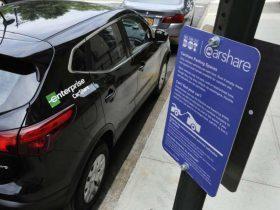Pittsburgh is a hub for AV development, and local companies are keeping sustainability in mind. But researchers and city officials still have concerns about the disruptive technology’s unknowns.
Though political fights and Tesla have pushed electric vehicles to the forefront of automobile industry news this year, one of Pittsburgh’s leading tech sectors could also be a key player in making transportation more sustainable than ever before.
Autonomous vehicles have a long history in Pittsburgh, starting with Carnegie Mellon University’s winning team in the 2007 DARPA Urban Challenge. Since then, several companies in the sector have built their headquarters here, continually bringing jobs, wealth and engineering prowess to the area. Pittsburgh, for its part, has welcomed the new technology, starting with Mayor Bill Peduto’s early work in allowing Uber to test its initial fleet of autonomous cars.
While a full commercial launch of the technology is still yet to come, recent announcements from two area companies indicate that momentum is building. But for all of the new convenience and efficiency these cars might offer, their environmental advantages are somewhat more nuanced than those of electric vehicles, leaving some to wonder how they will operate in a world that is de-emphasizing the trend of automobile transportation in the name of climate change.
Pittsburgh pollution
The main environmental benefit that autonomous vehicles offer is their efficiency: “Autonomous vehicles, in general, operate more optimally,” Neil Donahue, the director of CMU’s Steinbrenner Institute for Environmental Education and Research told Technical.ly. “They’re less lead-footy.”
More efficient driving means more efficient fuel usage, which should reduce vehicle emissions. That should mean cars will have less wear and tear over time and last longer, reducing both physical and energy waste that can come from automobile manufacturing. While Donahue acknowledged that the reductions would be less immediate than those seen with a switch to electric cars, he noted that even a small change can make a major difference to the region’s air quality.
“Autonomous vehicles, in general, operate more optimally. They’re less lead-footy.”NEIL DONAHUE, STEINBRENNER INSTITUTE FOR ENVIRONMENTAL EDUCATION AND RESEARCH
A research publication from June of last year led by CMU Associate Research Professor in Mechanical Engineering Albert Presto showed just how much local traffic emissions contribute to air pollution in Pittsburgh. He and his coauthors found that during the morning rush hour period after stay-at-home orders were put in place last spring, carbon dioxide and nitrogen dioxide levels decreased by about 50% — which was also the approximate percent decrease in traffic levels during that time. Notably, other major polluters in the area like the U.S. Steel-owned Mon Valley Works steel mills operated at the same production levels throughout this time period, as they were deemed an essential service.
Such a dramatic decrease in toxic emissions is uniquely significant to Pittsburgh, Donahue said. The region’s long recovery from the pollution of its industrial past paired with a topography defined by hills and valleys means that harmful particulates tend to linger and concentrate more here, and this study shows that vehicle emissions are responsible for a worrying amount of that.
Donahue sees all of this as a compelling reason to ensure all autonomous vehicles are electric, particularly as traditional car companies have started shifting to that technology.
“It matters where the electricity comes from,” he said, noting that many power plants still rely on fossil fuels. “But they are real wins in terms of the local air pollution.”
But ensuring that electric future happens isn’t always as simple as strapping autonomous technology onto an existing electric vehicle. The weight and energy requirements of the sensors and monitors needed already limit the range of traditional fuel-powered cars, and would likely require more frequent battery charging in electric models. Still, recent research from CMU has shown that the increased efficiency of the technology and certain design choices to reduce drag can make any difference in the driving range for electric autonomous vehicles negligible.
Pittsburgh plans
Local companies are keeping that in mind. Argo AI, which recently announced a new partnership to launch its first product with Ford and Lyft at the end of this year, has plans to develop an autonomous version of the electric microbus Volkswagen ID.Buzz for launch by 2025.
“Looking further out, we would expect all of our vehicles that we’d work with to be electric going forward,” Argo AI Director of Communications Alan Hall said. For now, tests of the company’s autonomous technology are done on older 2016 or 2017 hybrid car models.
Aurora, another local autonomous vehicle company that just shared plans to go public through a SPAC, also sees electrification as a goal for its technology.
“The Aurora Driver is designed to work across all vehicle platforms, including EVs, and we’re working with a range of vehicles readily available from our partners,” a spokesperson for the company said via email.
Even larger vehicle-focused companies like autonomous trucking firm Locomation, which has offices in the Strip District’s Robotics Row, want to see an electrified future for its technology, though the challenge there is much greater in terms of distance traveled and vehicle weight. Pointing to recent reports on the increasing availability of electric passenger cars, Locomation VP of Policy and Strategy Finch Fulton said “you’re seeing a lot of improvements on charging speed, charging capacity, and the range of vehicles.”
While that shows promise for smaller autonomous vehicles, Fulton — who formerly worked for the Department of Transportation — added that “the Department of Energy estimates that for Class 8 multi-motor vehicles, those will not be technically and economically feasible until 2030 or 2032.” But when that technology becomes available, it will undoubtedly address concerns around vehicles that still use diesel, which is known to produce higher levels of carbon dioxide and nitrogen oxides than gasoline-powered vehicles.
Locomation is also looking for ways to reduce the kinds of emissions that are unique to long-distance trucking, Fulton said. When human truck drivers need to take a break for sleep, they often do so in small cabins within the trucks, which typically need to use energy to be heated or cooled depending on the weather. But autonomous trucks wouldn’t have that problem — no one in the cabin to keep comfortable — and removing or reducing idling from even one truck could save up to 1,200 gallons of diesel and 24,000 pounds of carbon dioxide emitted per year, according to a report from the North American Council for Freight Efficiency.
Automated trucks would also benefit from speed control and smooth driving efficiency that smaller autonomous vehicles have. The negative impact on the environment would likely be less if trucks were programmed to go at a slower, more efficient and steady speed. Trucks traveling at a speed of 75 miles per hour, for instance, will burn 27% more fuel than ones traveling at 65 miles per hour, Finch noted.
Pittsburgh policy
Though local analysts, policymakers and researchers alike look forward to the myriad environmental gains of autonomous vehicle technology, many also remain wary about the rollout of this disruptive technology. Eric Beckman, the faculty co-director of the University of Pittsburgh’s Mascaro Center for Sustainable Innovation is particularly worried about what conservation and energy economists call the rebound effect.
“I think most people who look at autonomous vehicles, and are also interested in sustainability, worry about this kind of rebound impact where actually you can get more miles driven when it’s autonomous, because it’s so easy,” he said.
“I think most people who look at autonomous vehicles, and are also interested in sustainability, worry about this kind of rebound impact where actually you can get more miles driven when it’s autonomous.”ERIC BECKMAN, MASCARO CENTER FOR SUSTAINABLE INNOVATION
People who might have walked or biked somewhere before might more frequently turn to an autonomous vehicle in the future simply because the option might be more accessible to them. If that happens, Beckman sees the possibility of a scenario where autonomous vehicles are actually worse for the environment, since people would start using them more often than they used traditional cars. But he also thinks that fate is avoidable, so long as local officials and companies alike remain mindful of it as the technology becomes more present here.
“It’s kind of an unknown right now,” he said. “And until these things become more ubiquitous on the roads, I don’t know how we’re going to guess” what the outcome will be.
That one of many potential concerns Erin Clark, a policy analyst in the City of Pittsburgh’s Department of Mobility and Infrastructure, hopes to help resolve as autonomous vehicles become more present on city roads.
Though autonomous vehicle companies operate in the private sector, she and other City officials have worked to establish a relationship with local company leaders so that they can discuss strategies to avoid factors that could lead to such a rebound effect. Some of that work, she said, includes making sure these cars don’t compete with current public transportation systems or preventing the cars from “traveling zombie miles, looking for people to pick up.”
But Clark also acknowledges that the landscape is still constantly shifting around autonomous vehicles, and that much of the regulatory process around them could remain unknown until closer to a full commercial launch. Nonetheless, she shares the concerns of both Donahue and Beckman, and feels that the City’s continued conversations with companies about this technology will resolve any issues in its adoption along the way.
“I think having these conversations early and often with the private sector ensures that we’re saying our expectations to them,” Clark said. “We want this technology to advance because we think it could save lives and make people safer and hopefully, make transportation a bit more sustainable.”
Link: https://technical.ly/pittsburgh/2021/07/27/autonomous-vehicles-environment/?utm_source=pocket_mylist
Source: https://technical.ly
















Leave a Reply